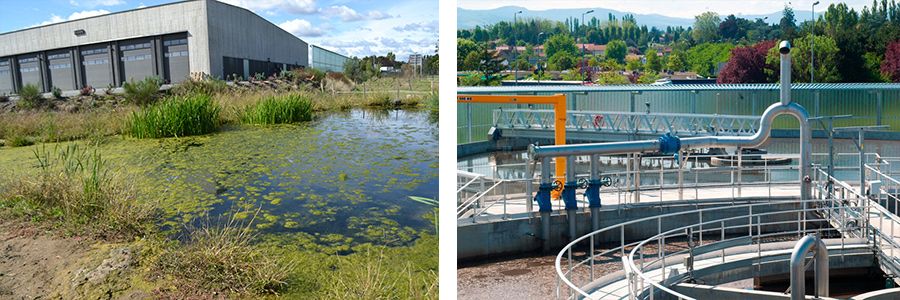[REGIONAL FOCUS ] Citeau: a virtuous water cycle
![[REGIONAL FOCUS ] Citeau: a virtuous water cycle](https://www.eclaira.org/data/sources/users/3/webtoit-vegetal4008.webp)
Located in Belleville, in the Rhône department, the Intercommunal water treatment centre (Centre Intercommunal de Traitement de l’Eau - CITEAU) was designed to be an ideas laboratory dedicated to sustainable development and a site for experimentation. It was commissioned in 2011, and is managed by the Saône-Beaujolais water treatment syndicate. It treats the water from Belleville, Saint-Jean-d'Ardières and Taponas.
When it was conceived, the project faced a challenge: turning the disadvantages due to its location into a positive feature. The CITEAU is located near the town centre, at the entrance to the town and within close range of a listed monument. The union was determined to do more than simply respect the standards imposed by the water board, and build an exemplary facility. The criteria taken into account for the design of the facility went beyond a mere response to its primary wastewater treatment function and also included appearance, biodiversity, and energy consumption and production.
The Citeau building is equipped with a green roof that improves insulation, biodiversity and landscape integration. Its lighting is mostly natural via skylights, and it is heated by recovering the waste energy contained in the effluents.
Biodiversity: an integral part of the treatment centre
The same determination was applied to the hectare of land surrounding the treatment centre. This kind of space is often left empty, occupied only by a lawn requiring regular maintenance. But the syndicate decided to make it into a biodiversity zone.
An organic orchard was planted in 2011, and other development work was gradually carried out. The site now has three pools, including one for educational purposes, and a meadow located on the site of the former treatment plant. Maintenance is carried out without using any fossil energy by two ponies and a flock of barnacle geese. The land is watered using purified water.
Citeau works with two associations on the development and monitoring of the biodiversity zone: the bird protection society (LPO) and Arthropologia, a naturalist association working for the protection of insects. About forty nesting boxes for birds and bats (the site has also been labelled an LPO refuge), an insect house and hives have been installed.

A wastewater treatment plant in synergy with the area
In 2012, a feasibility study confirmed the possibility of allowing a nearby property programme to benefit from heat recovery from Citeau's effluent. The syndicate then became a producer and seller of energy by creating a heat network and setting up heat sales contracts. It provides up to 80% of energy for heating, cooling and domestic hot water for over 80 homes, offices and shops. This innovative system makes it possible to divide the carbon footprint of the property complex (which has a total surface area of 9,000 m2) by a factor of three. This system is now being expanded. In addition, sewage from the plant is used for agricultural composting and the sands are washed to be reused.
Why should biodiversity issues be included in circular economy projects?
For the syndicate’s president, Frédéric Pronchéry, biodiversity should be included in all projects, to varying degrees depending on their nature. Sanitation is very expensive for local authorities, and yet they tend to hide away their wastewater treatment plants. Conversely, in Belleville the idea is to showcase what is being done in the plant, the emphasis being on the educational and exemplary nature of the site.
Developments in favour of biodiversity make it possible to compensate for the urbanization and artificialization caused by building facilities. At Citeau, these developments also have an important educational role. The plant opens its doors, especially to schools, to show them how its different functions - sanitation, energy production and biodiversity reserve - operate. It displays the water cycle as a virtuous circle.
“There shouldn’t be any projects without biodiversity”
How can the environmental aspect, and in particular biodiversity, be better taken into account?
Taking the environment into account implies designing projects that do not correspond only to a single use. This principle must be defended. In the case of Citeau, the choices made are the result of a strong political will on the part of the elected representatives of the three towns concerned. It must also be realized that the “biodiversity budget” represents a low cost compared to the total cost of such a facility. Incentives, especially financial incentives, and regulations have an important role to play in better including criteria such as biodiversity in projects. The latter also require the expertise of professionals.
To set up innovative projects, such as the recovery of waste heat, it is also a question of convincing the partners (in this case the stakeholders of the property programme: developers, builders and buyers), and financiers (the water board, ADEME, the Auvergne Rhône-Alpes Region and the Rhône Department).
The innovations and initiatives deployed at Citeau are recognized at the national level. Energy production is of particular interest because of its reproducible potential. The ambition is now to continue down this path, to inspire the same determination in other projects within the inter-communal authority area.
Photo credits: Citeau
Source: ECLAIRA - Newsletter No. 11 / July 2018
Read and download the ECLAIRA Newsletter No. 11
Newsletter edited by CIRIDD with support from Région Auvergne - Rhône-Alpes